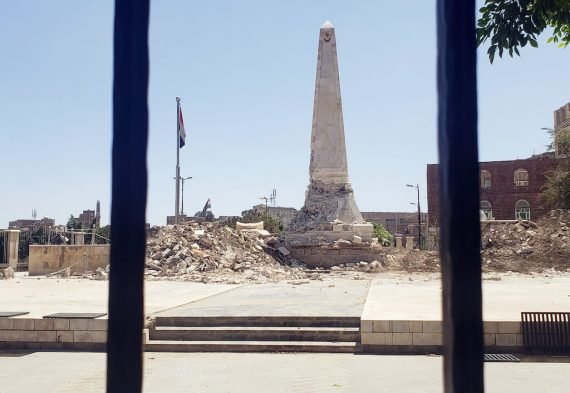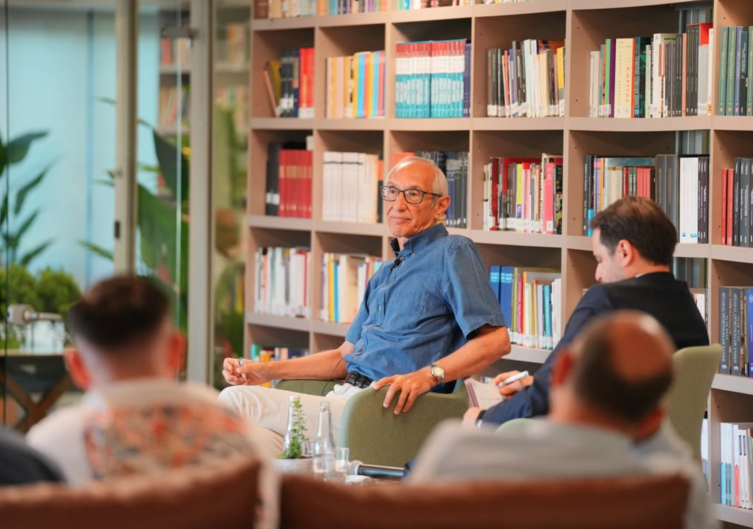On March 12, 2022, Houthis, who currently control the Yemeni capital, Sana’a, demolished part of the memorial to the martyrs of the Ottoman Empire in Yemen. This move speaks of a series of conflicts between the Ottoman administrators and Zaydi imams, the last of which ended with the signing of the Treaty of Da’an in 1911.
The memorial was erected on the western bank of the waterway dividing the historical city of Sana’a in two, near the Al-Aridhi Complex. Its various sections were built by the Ottomans in intermittent periods, and the complex was later turned into large headquarters for the army command, becoming one of the symbols of the Ottoman presence in Yemen.
The Al-Aridhi Complex was built by the Ottomans near the southern wall of the city of Sana’a as the most important architectural facility outside the old city. It was restored and some facilities were added to it at the end of the rule of President Ali Abdullah Saleh (1978-2012), who turned the complex into headquarters for the Ministry of Defense and the Supreme Command of the Armed Forces. Saleh exercised his presidential duties periodically during the week from the same complex.
The establishment of the memorial graveyard dates to 2011 when it was inaugurated by then Turkish President Abdullah Gül during an official visit to Sana’a, on January 11, 2011. The memorial is symbolic of the bilateral relations, and the Turkish flag continued to fly at an important place in the capital of Yemen—before it had flown only above the Turkish embassy or the ambassador’s residence. The flag flying over the memorial remained exceptional in every sense of the word.
The Zaydi Imamate and the Ottomans: A history of hostilities
It is not possible to understand the Houthi attacks on the Ottoman memorial graveyard without delving into the historical background of the incident, which was widely condemned by Yemenis, as the demolition was linked to the Zaydi Houthi group.
The Zaydi presence in Yemen dates back to the late 9th century, when a person known by his honorific title Imam al-Hadi ila’l-Haqq (835-911) came to Yemen, specifically to Saada, in the northwest of the country.
The Zaydi sect spread in the northeastern mountainous areas of Yemen very slowly, and the influence of Imam al-Hadi’s sons continued. However, they were not able to found a state to rule over Yemen except in intermittent periods, which completely coincided with the decline in the central rule of the Ottoman Empire.
One of the most important reasons for the Ottoman presence in Yemen and the Arabian Peninsula, since the beginning of the sixteenth century, was to face the threat of Portuguese and Western incursions and the resulting fears of their arrival to Mecca and the holy sites.
A sectarian enmity was built up through cycles of violence and intermittent armed conflicts that were waged by the Zaydi imams and the tribes loyal to them against the Ottoman Empire, especially in northwestern Yemen. The Ottoman Empire did not recognize the authority of the Zaydi imams which worsened their ties to Islam and the Ottoman sultan, thus impacting their ability to rule over Ottoman lands.
Furthermore, the imams who revived the collapsed Zaydi state in Tabaristan, to the north of Iran, were looking to establish a Shiite Islamic empire centered in Yemen, but all factors indicated the impossibility of their ambition. The latter was related to the weakness of their capabilities compared to the profound influence of the Ottoman Empire.
A historical assessment of the Ottoman presence in Yemen
Since the fall of the Zaydi Imamate in Yemen on September 26, 1962, at the hands of the Yemeni people, who were fed up with them, and the consequent establishment of the Yemeni Republic, the historical assessment of the Ottoman state and its role in Yemen remained a subject of tension between the majority of Yemenis that viewed it as a natural extension of Muslim nation and a minority that went as far as to describe it as an “Ottoman invasion.”
History textbooks, which were adopted after 1962, presented a positive view of the Ottoman Empire and its rule over Yemen. Nevertheless, this did not prevent Zaydi supporters from maintaining their strict and extremist position on the Ottoman Empire and on the Sunni majority that controlled the public in Yemen during the past six decades.
The view of this historical assessment is necessary to assess the motives that led the Houthis to demolish the Ottoman monument to the martyrs of the Ottoman Empire who had lost their lives in conflicts and confrontations resulting from the Zaydi imams and their rebels in northern Yemen, whose main goal had been to weaken the Ottoman Empire. This goal seemed to have been shared with the Safavid Shiite regime in Iran, thus establishing an invisible shared aim between the hard-liner Zaydis in Yemen and the most extreme Shiite scholars and thinkers in Iran.
Therefore, the Houthis’ demolition of the historical Ottoman monument shows an extremist historical ideological reaction that indicates the fanatic background of this group which wants to revive the Zaydi Imamate. The Houthis consider themselves an extension of the Zaydi imams, and feel entitled to seize the moment to resolve the current war in their favor.
Considering the end of the war with the Treaty of Da’an in 1911, Imam Yahya Hamid al-Din’s a war against the Ottoman Empire came at a time that took full advantage of other historical circumstances. The Ottoman Empire was facing the Italian invasion of Libya, a revolution in the Balkans, and was in a dire need of ending the military attrition it suffered at the hands of the Zaydis in Yemen
The agreement maintained the Zaydis’ influence in Yemen and granted the Zaydi imam the powers to supervise his Zaydi sect. It also meant that the imam would seek outside support which came from Iran. This became a tradition that continues on from the ninth century seen in the Iranian interference in Yemen’s affairs.
Recommended
The political and regional dimensions
The Houthis chose a timely moment to demolish the historical Ottoman monument: the visit of Israeli President Isaac Herzog to Ankara. In my estimation, the demolition of the monument can be attributed to three reasons.
The first is that the Shiite Houthi group, as a sectarian minority, does not want the Yemeni people to retain a positive historical memory of the role of the Ottoman Empire in their country. Thus, this is a message to Yemenis that there is no legitimate authority other than the authority of the Zaydi imams who today rule Yemen with an iron fist.
The second reason relates to the role played by regional powers, led by Iran, and Arab countries linked to the West. These countries, of course, do not want Turkey to have any historical impact on Yemen.
The third reason is that the Houthi group is trying to stop any future role for Turkey in the region, especially in Yemen. The Houthis know that a large segment of Yemenis have good relations with Turkey and aspire to implement the Turkish model in Yemen; they, on the other hand, aim to break away from Turkey. The Houthis fear the influential role of the current Turkish Republic and the history of the Ottoman Empire in Yemen.





